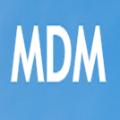Molecule generation, especially generating 3D molecular geometries from scratch (i.e., 3D \textit{de novo} generation), has become a fundamental task in drug designs. Existing diffusion-based 3D molecule generation methods could suffer from unsatisfactory performances, especially when generating large molecules. At the same time, the generated molecules lack enough diversity. This paper proposes a novel diffusion model to address those two challenges. First, interatomic relations are not in molecules' 3D point cloud representations. Thus, it is difficult for existing generative models to capture the potential interatomic forces and abundant local constraints. To tackle this challenge, we propose to augment the potential interatomic forces and further involve dual equivariant encoders to encode interatomic forces of different strengths. Second, existing diffusion-based models essentially shift elements in geometry along the gradient of data density. Such a process lacks enough exploration in the intermediate steps of the Langevin dynamics. To address this issue, we introduce a distributional controlling variable in each diffusion/reverse step to enforce thorough explorations and further improve generation diversity. Extensive experiments on multiple benchmarks demonstrate that the proposed model significantly outperforms existing methods for both unconditional and conditional generation tasks. We also conduct case studies to help understand the physicochemical properties of the generated molecules.
翻译:分子的产生,特别是从零开始产生3D分子的分子成像(即 3D \ textit{de novo} 一代),已经成为药物设计的一项基本任务。现有的基于扩散的3D分子生成方法可能因不令人满意的性能而受到影响,特别是在产生大型分子时。与此同时,产生的分子缺乏足够的多样性。本文件提出了一种应对这两个挑战的新颖的传播模式。首先,分子的3D点云表显示中没有进行跨原子关系。因此,现有的基因模型很难捕捉潜在的内分解力量和丰富的当地限制因素。为了应对这一挑战,我们提议增加潜在的间生力量,并进一步使用双等异分子编码,以编码不同力量的互通性力量。第二,现有的基于扩散的模型基本上在数据密度梯度的几何学上转移要素。这一过程在分子的中间步骤中缺乏足够的探索。为了解决这个问题,我们引入了一种分布控制变量,在每一个步骤中都可进行彻底的内分流和反向上的变化,以进一步加强下一代的多样性。为了应对这一挑战,我们提议的挑战,我们建议增加潜在的间生化多样化,我们提议进行多种试验,还原试验,以显示现有的案例研究。我们提出的模式的公式分析方法将产生。




